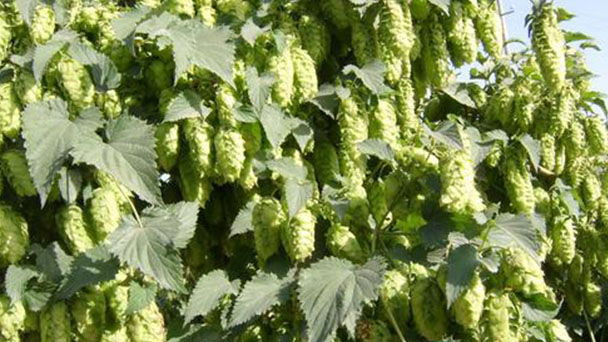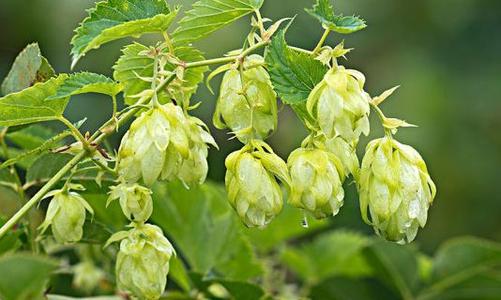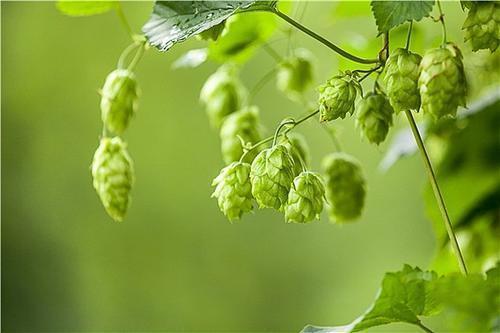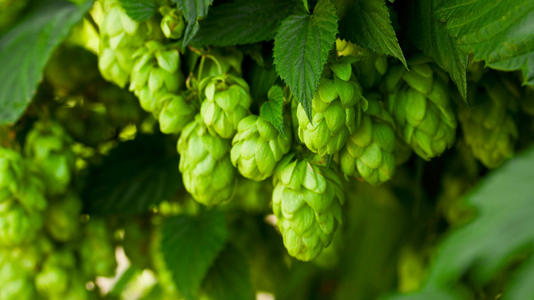How to grow and care for Common hop
Written by Maggie
Jan 09 2021

Common Hop is a perennial herbaceous vine of the family Moraceae, Humulus scandens. Common hop vine is over 6m long, with dense fine hairs and barbs throughout the body, native to Europe, America and Asia, can be used for brewing beer and medicine. So how does Common Hop grow? What good method is there for growing? What matters should we pay attention to in growing Common hop? Please read with me growing methods of Common Hop and Common Hop care!

Growing Common Hop
Best growing time: common hop is generally best grown in the early and middle of April, flowering from July to August, fruit from September to October.
Best growing soil: Common Hop is not selected, but deep, loose, fertile, good aeration loam soil is preferred, and can be neutral or slightly alkaline soil.
Growth humidity requirements: Common Hop annual sunshine hours of 1700 ~ 2600 hours.
Best growing temperature: Common Hop likes cold, cold and heat resistant, suitable temperature for growth of 14 ~ 25℃, the requirement of frost-free period of about 120 days.
Best growing light: Common Hop is a long-day plant, light loving.
Aquaculture growing method of Common hop
1. Seedling treatment: Dig up Common Hop planted in soil, clean it with clean water, cut away dead leaves, diseases and insect pests, and soak in diluted flower nutrient solution for half a day.
2 on the pot: Take a glass bottle or vase (without bottom hole), put a few pieces of beautiful river stone in the bottom of the bottle, the processed Common Hop seedlings into the vase river stone, spread out the roots, add water, add flour nutrition solution, placed indoors or in the shade.
3. Management: 1. Spray the leaves with clean water once a day, and spray the leaves with flower nutrient solution once every three to four days after one or two days.
Growing Common Hop in the soil
According to the climate conditions, varieties and frame shape, the plant spacing is 0.5 meters in the same year, row spacing is 2.5 to 3 meters, the next year every other plant sparse to one plant, so that the plant spacing is maintained at about 1 meter. Before transplanting, soak the seedlings in 0.5 {bf} Bordeaux for 5 min to prevent infection by insects and diseases. When transplanting to 45 degrees to the sun planted in the middle of the trench pit, the top of the seedlings from the surface of 10 ~ 12 cm covered with soil, soil after filling 5 cm, irrigation after planting. About 20 days after the spring planting is excavated, timely check the emergence of seedlings as soon as possible.
Common Hop care
Fertilizeing care
Fertilize Common Hop: in conjunction with irrigation. Nitrogen fertilizer was applied at seedling stage, 10 ~ 15 kg per acre. Compound fertilizer was applied once at budding stage and flowering stage.8 ~ 10 kg per acre, before the winter application of organic fertilizer, about 3000 kg per acre.
Watering care
Common Hop growth period and before the winter if the water shortage, it will affect the growth and yield, especially the flowering period must ensure enough water, in Xinjiang during the whole growing season about 7 ~ 8 times of irrigation.

Pruning care
Common hop pruning includes thinning and shortening. In order to adjust the Common hop tree posture, which is conducive to ventilation and light, usually dead branches, disease and insect branches, thin school, parallel technique, empty long core, dense branches and so on are cut off, that is, thinning technique. When thinning branches, the stump should not be too long, nor should it cut into the next level of branches. The upper cut should be made at the branch point, and then cut at a 45° oblique Angle. The cut should be smooth
Pot soil replacing care
Do not water before removing the pot in Common Hop. To operate, first tap the basin around with your hand, then hold the Common Hop with one hand, and pull the finger of the other hand into the drain hole, so that the root with the soil out of the basin. After taking off the pot, remove part of the old soil with a bamboo stick, generally remove one-third to half. Mat in basin bottom broken basin piece, big, deep basin is some more cushion, be helpful for drainage. The bottom is then covered with soil, followed by plants that have removed the old soil and trimmed the roots. Finally, the new soil is covered and compacted.
Propagation care
Common Hop has seeds, underground stem cuttings, green branch cuttings, bud planting methods such as propagation.
(1) Seed propagation: This method of propagation is mainly used for hybrid propagation. Because of the hard seed coat of Common Hop, most seeds are stunted and the germination rate is low, this method of reproduction is generally not used in production.
(2) Underground stem cutting propagation: This method is simple and easy to operate, and is widely used in production. Generally, when buds are cut in late autumn or early spring, sturdy underground stems with a length of about 12 cm, a stem diameter of 1.8 cm and smooth incision at both ends are taken as seedlings for direct planting.
(3) Green cutting method: This method of propagation is coefficient and survival rate is higher.
(4) Bud planting method: when cutting the buds, the buds will be 6-13 centimeters long, full and healthy and with a small number of roots, according to the plant row distance of 30×60 centimeters planted in the nursery. The requirements of all the buds planted in the soil, the spacing of the buds on the ground 3 centimeters, covered with soil 2 centimeters, maintain soil moisture, strengthen management.
Common Hop pest control:
Common Hop mainly has downy mildew, corn borer, red mite cinnabarinus, snail, demoiselle moth, root cancer and so on
1. Downy mildew:
Root rot Downy mildew and root rot are fatal diseases of the Common Hop. The germ of root rot disease is from the wound of rhizome invasion, the initial stage of the disease is yellowish bulge, gradually expand, the surface has rough and irregular tumor, cause root rot, the new bud of the victim plant is little and stunted, the yield is low, the quality is poor.
Prevention and control methods: In addition to strengthen field management and remove the source of disease, spray 250 times of Rheumatoid liquidus in the soil around the roots in early spring combined with bud cutting, and start spraying 200 to 250 times of Rheumatoid liquidus or the same amount of Bordeaux liquidus 100 to 200 times once every half a month for a total of 7 to 8 times, which can achieve good results.
2. Corn borer: Occurs in early June until autumn.
Prevention and control methods: at the end of May and early June, the Common Hops were found to have the same withered leaves as hot water, and it should be removed together with the petiole in time, and focus on burning or compost. The main vine (stem) is killed, do not have to pull the stem broken, and we can use a sharp knife along the wormhole up the stem side carved (longitudinal cut) kill larvae, the hops can still continue to grow, flowering and cones. In the early stage of occurrence or larvae before the third ininstar has not been drilled into the vine, with 90 {BF} trichlorfon or 80 {BF} dichlorvos 800 ~ L000 times or BT emulsion 200 times the liquid control.
3. Tetranychus cinnabarinus:
From July to August, high temperature and drought were rampant. The harm hops first from the lower near the ground of the old leaves, gradually upward development. Later it is drying off, and growth is weak, affecting the formation and expansion of the flower bulb, but also harms the cones of hops, resulting in lower yield, quality deterioration.
Prevention and control methods: After the Common Hop harvest, the winter and spring combined to dig the land, remove weeds and withered vine, destroy the wintering place, reduce the wintering insect mouth; Legume crops should not be intercropped in Common Hop field; On the basis of doing a good job of vines on the shelf work, timely thinning branches and playing leaves, so that the shed ventilation and light, to promote the growth of hop; At the initial stage of occurrence, 1000 times of 40 {BF} oxidate solution and 1000 times of 20 {BF} dimethylamine solution were sprayed.
4. Snail: It is an important pest in the hops seedling stage. After the hops emerge, they gather in the hops and lick the leaves and tender stems (tendrils), causing holes or tender tendrils to be licked off, affecting the growth of hops.
Prevention and control methods: According to the characteristics of snail nocturition, artificial killing, mash as feed or compost; Remove weeds or pile up weeds in the ground to trap or spread barley to reduce harm; Master the spawning period, timely plowing weeding, eliminate a large number of eggs, reduce harm; Spray 1 {BF} lime water and 5 ~ 6 kg rapeseed cake powder per acre.
5. Demoiselle moth: also known as debt moth, harms wine flower stems and leaves. Common Hop in Hangzhou, Shandong and other production areas were seriously damaged by small demoiselle moths, which caused yellow leaves and weak growth, and affected the yield of summer and autumn flowers.
Prevention and control methods: Remove the early hanging pouch in time to eliminate the larvae;In July ~ August, 90 {bf} trichlorfon 1000 times liquid plus 0.2 {bf} neutral soap can be used, or 80 {bf} dichlorvos 1000 ~ 1200 times liquid spray can be used, every 7 days 1 time, continuous spray 3 times, spray in the evening or early morning.
6. Root cancer: Common Hop occurs mostly in the root neck below the soil surface of the plant, with a small number occurring on underground stems and vegetative roots. They are the size of bean grains, white and tender in texture. With the rise of temperature, the tumor increases rapidly, and its color gradually turns to light yellow. The surface of the tumor is rough and there are small nodular projections, and there are irregular small furrows between the tumors. The tumor can be more than 16 cm in diameter. By autumn, a few growths appear above the ground. After overwintering, when spring bud cutting, most of the nodules decomposed, a few were in decay, most of the infected plants tended to die, and some of them did not die, but only produced weak regenerated branches.

Prevention and control measures:
1. Choose loam soil with low groundwater level, good drainage, light saline-alkali soil and loose soil quality for planting.
2 Strengthening management timely loose soil topdressing, pay attention not to root damage, fertilization to nitrogen, phosphorus, potassium. Do not flood irrigation, especially high groundwater level, poor drainage of low land should pay more attention to the amount of irrigation, and can not make the soil too wet.
It is forbidden to propagate disease-free seedlings by using the seedlings above the diseased plants.
4 Timely removal of pain and prevent wound infection, and do a good job of bud cutting tools disinfection spring and autumn bud cutting. Once found, the tumor should be immediately removed, and promptly destroyed or buried. Sprout cutting wounds, tumor cutting wounds and sprout cutting tools need to use 0.1 {BF} mercury solution, or lime milk coating, and we can also use sulfur soil (1∶125) evenly spread on the root, more than 50 grams per plant.30 {bf} unate copper fertilizer (DT), carbendazim, methyl tobujin 500 times solution can also be used to spray the wound to prevent wound infection.
5. When the sick plant is serious, it should be uprooted, taken out of the field and buried deep, and the holes should be disinfected with quicklime or 1 {bf} copper sulfate.
Latest Updated
- Benefits of Bugleweed - 7 Science-backed Health Benefits
- Bugleweed Dangers & Side Effects - Is It Poisonous?
- How to Plant Evergreen Trees - What You Should Know
- When to Plant Evergreens - Grow Guide for Evergreen Trees
- 12 Wonderful Evergreen Shrubs for Your Garden
- 12 Popular Evergreen Plants with Pictures for Beginners
- When And How To Prune A Lilac Bush Like a Pro
- How to Grow & Care for Lilac Vine (Hardenbergia Violacea)
- Japanese Lilac Tree (Syringa Reticulata) Care & Propagation Guide
- Shumard Oak Pros and Cons - What to Know
Popular Articles
- Winter maintenance of Antirrhinum Majus
- How to Grow Terminalia Mantaly Tree
- How to Grow and Care for Crossostephium Chinense
- How to grow Antirrhinum Majus in spring
- Peristeria Elata (Dove Orchid) Profile: Info & Care Guide
- Underwatered Snake Plant (Sansevieria Trifasciata) - Signs And How To Fix
- How to Care for Brazilian Jasmine Plant (Mandevilla Sanderi)
- How to Grow & Care for Graptopetalum Purple Delight in Summer
- Rosa Chinensis (China Rose): Plant Growing & Care Tips
- How to Care for Baby Sun Rose (Aptenia Cordifolia)